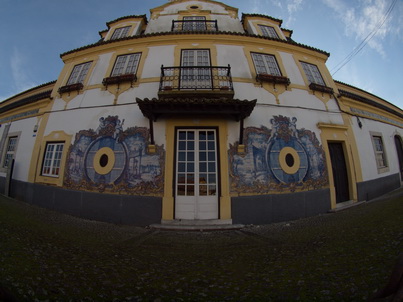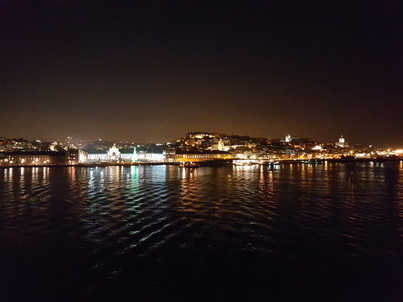|
|
|
|
|
|
zurück Aida 16/17 Setubal Brena Lisboa Azeitao Portweinverkostung Azeitáo
 |
 |
| Jose Maria da Fonseca Portwein in Azeitáo 1 | Jose Maria da Fonseca Portwein in Azeitáo 3 |
|
|
 |
|
José Maria da Fonseca Vinhos SA Quinta da Bassaqueira 2925-511 Azeitáo Tel: +351 212 197 500 Fax: +351 212 197 501 E-Mail: info@jmf.pt mehr Portweine von José Maria da Fonseca Vinhos |
Lisboa Tejo 1  |
| Jose Maria da Fonseca Portwein in Azeitáo | Lisboa Tejo 1 |
At the entrance to Villa Nogueira de Azeitao an unusual pattern of a traffic
island give a sign that this small town is the most famous wine village south of
Lisbon. Instead of the usual floral decorations or even modern sculpture art,
here is a pyramid of old wooden barrels, reflecting the subtle imprint "JMF" in
white letters, short for Jose Maria da Fonseca. Only a few meters away is one of
the largest wineries in Portugal, the family fills there current 18 million
liters of wine per year, and most of it spread over the entire globe. And with
the Bacalhoa Vinhos, formerly known as JP Vinhos, the small town on the
peninsula of Setubal, just 30 minutes' drive from the capital, even has a second
about the country's borders known winery.
In the inner city, the streets are narrow. Mansions from the 19th Century,
various cafes and small shops dominate the picture. Amidst this bustle lies the
manor house of JMF. Its football-field-wide, handsome facade hints at first that
inside is a beautiful garden, the old cellars and warehouses for Moscatelwines
are. The old winery, which was later in the mid-80s too small, is now the
featured the company museum. Each year, about 30,000 visitors discover here the
story of the producer, who began 1834 with vineyards, and is now one of to the
world famous wineries. The visitor can also have a large part of the portfolio
to taste, which includes more than 30 different wines.
The blockbuster, which was responsible for this success is Periquita. The
best-known wine brand in Portugal. One of the oldest wine brands in Portugal.
The first mention of this red wine dates from 1850. The oldest still-existing
bottle is 30 years younger. Domingos Soares Franco, a direct descendant of the
founder, leads the company today with his brother Antonio. According to the
different characters they split their tasks. Antonio, the elegant and accurate
business man is responsible for the business management. Domingos the inventive,
creative, sometimes scattered one, is the winemaker. A man who do his profession
withreal passion and enthusiasm. He could have retired long ago. But instead of
enjoying the fresh sea air in the heights of the Arrabida, a small mountain
range, which shields Azeitao from the Atlantic as a pensioneer, he rather
experimented with new blends. The history of the flagship of the company, which
arrived in the meantime in the 20th century in the possession of an American
consortium, he knows well. "By 1940 Periquita came mainly from gravel soils from
the area around Azeitao," he says, knowing that today's production figures, this
no longer allowing. "Later, the blend is made more with grapes from sandy soils,
which are in the north and east of our growing region Pamela". Castelao is still
the main component of Periquita, but the blend includes 20% Trincadeira and 10%
Aragones, currently filled six million bottles annually.
The second hobby is the Moscatel de Setubal. One of the great fortified
sweet wines on the planet. The two enormous old warehouses, which connects
directly to the courtyard garden, are a treasure of unimaginable value. Overall
in the JMF Lodges 400.000 liter just fine, aged Moscatel is stored in pipas. And
Domingos Soares guards this with the same passion, as his ancestors. For the
regular quality control and selection of barrels, which are needed for the
blends, the experience of the winemaker is irreplaceable. But about the history
of the Moscatel of Setubal,he makes no romantic illusions. Model was the port
wine. Its oxidative removal copied by the growers in the area of Setubal. The
founders initially acquired some barrels and then began in the 19th century to
create their own barrel storage. The biggest difference to the port are the used
the grape variety. The wine from Douro is known for more than 80 different
varieties are cultivated and mixed. The local sweet wine is mainly made from the
grape Moscatal de Alexandria, a bastard of the in Europe known grape Muscat. And
in very limited quantities are also Moscatel Roxo and Bastardinho used. Further
expansion is then similar to a Tawnyport. The base wines are three or five years
old, as blend or bottled as young vintage wines. The complex Moscatels are
beginning with the 20 years Alambre and Alambre Roxo, a blend whose youngest
barrel has aged for 20 years. Or the legendary Trilogia, a blend of the three
vintages 1900, 1934 and 1965. These are great, delicious dessert wines.
The JMF is take seriously as a quality producer in the reds too, proves the
super-premium line. In addition to the wines from the headquarters, the region
Pamela, JMF also has vineyards in the Douro and Alentejo. Hexagon, the
Periquita Superyor, and FSF are the main wines of the primary growing
region. Hexagon is a complex blend of six different varietals. Syrah, Tannat and
Trincadeira form the international glare are the blend for FSF. The Periquita
Superyor a 100% wine from Castelao, aged 6-8 months in new oak barrels.
Domini Plus comes from the Douro , a red wine that is in contrast to many
other first growths in that region, rather elegantly.
From Alentejo finally come to the "J" and the "Jos? de Sousa Mayor". Both
are the result of a rigorous selection, mostly Touriga Franca and a small
addition of Grand Noir and Touriga Nacional. By "J", the top wine, which was
first produced in 2007, it's just something about 1500 bottles, this wine is
aged in the Alentejo traditional amphora. The wine is complex, more elegant and
with an excellent fruit aromas, fresh and at the same time, with soft tannins.
Surely one of the best wines in Portugal. Jose Maria da Fonseca is a generator
that can boast both a broad, immaculate baseline as well as with a variety of
top segment and therefore far right is known beyond the borders of Lusitania.
Porto, Madeira – und Moscatel: Portugals (fast) vergessener Dessertwein von portugalmania.deDie dunkelgelb schimmernde Farbe, der würzige Geschmack von Trauben mit einer Prise Atlantikluft: Der Dessertwein “Moscatel de Setúbal” gibt seine Geheimnisse nur Schlückchen für Schlückchen preis. Dieses Jahr ist die perfekte Gelegenheit, den fast vergessenen “kleinen Bruder des Portweins” wieder zu entdecken: Denn der Moscatel feiert seinen 100. Geburtstag – offiziell zumindest, denn die Geschichte des Weins und seiner besonderen Traube geht zurück bis zu den alten Ägyptern.
“Vinho Generoso” nennen die Portugiesen ihre süßen Dessertweine, wie etwa den weltbekannten Portwein. Übersetzt heißt das: Großzügiger, freigiebiger Wein. Der Gattung nach gehört auch der Moscatel de Setúbal zu den “großzügigen Weinen” – mit seinem schüchternen Auftreten und wenig Gewese um sich selbst zählt er jedoch eher zu den scheuen Vertretern seiner Art. Dabei hätte der Moscatel eine falsche Bescheidenheit gar nicht nötig – enthält er doch die Spuren einer langen Geschichte und kann mit dem üppig wuchernden Charakter seiner Heimat, der Naturregion “Serra da Arrábida” punkten. Nicht im überzeugten Rubinrot des Portweins kommt der Moscatel daher, sondern in einer dunkelgelb-orange schimmernden Farbe – ein Ton, so voll und reich beladen wie das Licht beim Sonnenuntergang nach einem warmen und satten Sommertag. Und auch im Geschmack setzt der Moscatel seine eigenen Akzente: Trotz seiner edlen Süße bewahrt er sich würzige Noten im Aroma, den Duft von Blüten und einen Hauch Salzluft aus dem nahen Atlantik. Über Jahrhunderte hinweg hat sich der Moscatel so seinen eigenen Charakter bewahrt – und schien auch stets mit sich selbst zufrieden zu sein. Während es den Portwein über die Grenzen hin zu weltweiter Beliebtheit zog, blieb der Moscatel de Setúbal fast ausschließlich der eigenen Heimat verbunden. Selbst in Portugal ist der Moscatel eine stellenweise unbekannte Größe. Getrunken wird der Wein zumindest fast ausschließlich rund um sein Anbaugebiet in der Serra da Arrábida in Setúbal und Lissabon. Größere Mengen für den Konsum stünden auch gar nicht zur Verfügung: Das Anbaugebiet der Moscatel de Setúbal-Traube (zu Deutsch: Muskateller) umfasst gerade einmal 330 Hektar – die Trauben für den Portwein nehmen eine hundert Mal größere Fläche ein. Trotz des geringen Bekanntheitsgrad ist der Moscatel alles andere als eine Provinzgröße. Eine geschützte Herkunftsbezeichnung (“denominação de origem”) schützt die besondere Herstellungsweise des Dessertweins. So besteht der Wein zu mindestens 85 Prozent aus Trauben der Sorte “Moscatel de Setúbal” sein (oder der roten Variante Moscatel Ruxo). Die Reifezeit muss mindestens zwei Monate betragen. Qualitätsgarantien, die nun genau ein ganzes Jahrhundert Bestand haben. Ein offizieller Geburtstag – doch die Geschichte der Traube und des Weins geht viele hundert Jahre früher zurück. Es waren die Römer, die die Vorzüge der ursprünglich in Ägypten beheimateten Moscatel-Traube erkannten – und diese dann in die mediterranen Ecken ihres Weltreiches exportierten. Portugal, das einstige Lusitanien, war mit seinem atlantischen Klima vielleicht nicht die ideale gleichermaßen zum Verzehr wie auch für den Weinanbau geeignete Traube. Doch an manchen Punkten, wie etwa in der gegen die strengen Atlantikwinde geschützten Serra da Arrábida mit ihrem fast mediterranen Klima fand der Weinimport aus Ägypten eine Heimat. Selbst zu Zeiten der eher abstinent lebenden Mauren pflegten die Menschen dieser Region den Anbau der Moscatel-Traube. Kein Wunder, dass man bei einer derartigen Kontinuität die Kultur- und Naturlandschaft auch im Geschmack des Moscatel-Weins wiederfindet. Und so lohnt es sich auch besonders, den Moscatel in seiner Heimatregion kennenzulernen. Eine gute Möglichkeit für eine Entdeckungsreise in Sachen Moscatel bietet die Touristenroute “Por Terras da Arrábida“, eine von sechs verschiedenen “Weinrouten auf der Halbinsel Setúbal“. https://www.rotavinhospsetubal.com/ |
14.10.25 Copyright Kaeltetechnik Rauschenbach GmbH Phone +49 2261 94410 Impressum Datenschutz Angebote nur an Geschaeftskunden